Getting your snowmobile’s track adjusted correctly doesn’t have to be complicated. In this guide, we’ll show you the tools, step-by-step instructions, and troubleshooting tips for all major brands — Polaris, Ski‑Doo/Lynx, Arctic Cat, Yamaha, and more. If you do it right, your snowmobile will run great quickly. Why Track Tension Matters Track tension directly affects […]
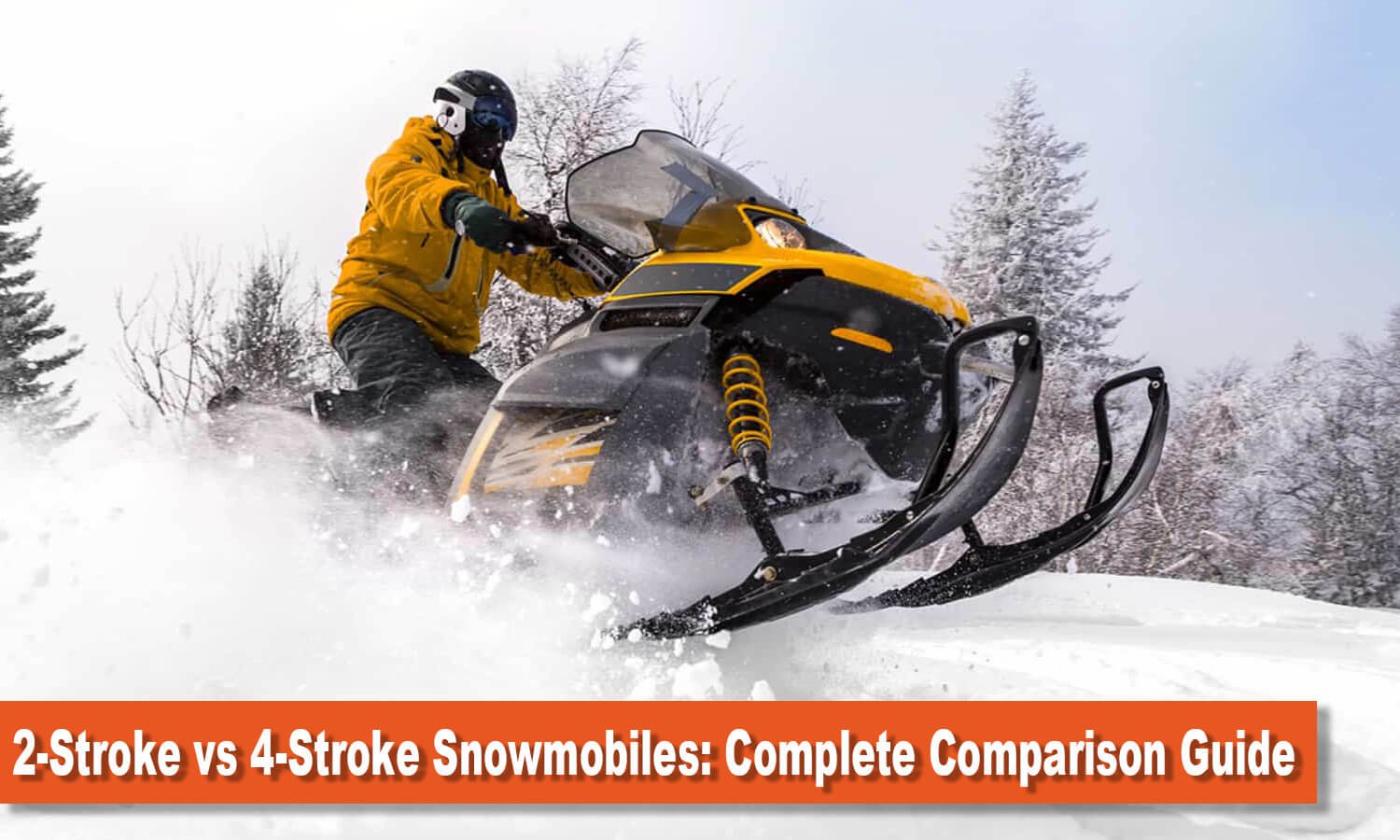
2-Stroke vs 4-Stroke Snowmobiles: Complete Comparison Guide
Choosing a snowmobile engine as a beginner is overwhelming—after all, it's not just metal and gas, it sets the stage for your entire experience. Understanding 2-Stroke vs 4-Stroke snowmobiles is a key starting point, as every engine has its own range of qualities in power delivery, weight, fuel efficiency, noise, and maintenance.
This article will walk you through everything you need to know so that you can confidently select the engine that best meets your riding requirements.
Table of Contents
Engine Basics and How They Work
Snowmobile engines cycle through intake, compression, power and exhaust strokes.
A 4-stroke engine does this in four piston movements (intake, compression, power, exhaust) over two crankshaft revolutions.
A 2-stroke engine completes the cycle in just two strokes and one crankshaft revolution, so it fires on every crank spin.
- Cycle: A 2-stroke fires every crankshaft turn, giving a power stroke on each revolution. A 4-stroke fires once every two revolutions (every other crank turn).
- Lubrication: 2-strokes mix oil in the gas, so fuel and oil go together through the engine. 4-strokes have separate oil and gas tanks (like a car), with oil kept in a crankcase.
- Components: 4-strokes have extra parts (valves, camshafts, a separate oil pump) that 2-strokes lack. This makes 4-strokes mechanically more complex but also smoother and more durable.
Because of these differences, 2-stroke engines tend to be lighter and high-revving, delivering explosive power for their size.
4-stroke engines run more smoothly, with strong low-end torque, and burn fuel more completely.
In short, 2-strokes trade fuel economy for power, while 4-strokes trade some power for efficiency and longevity.
Snowmobile Intercom Solutions for Better Group Talk
2-Stroke Snowmobiles vs. 4-Stroke Snowmobiles
Performance: 2-Stroke vs 4-Stroke
2-stroke snowmobiles usually feel faster and more reactive thanks to their lighter weight and the fact that they fire every crankshaft revolution. The result is sharp, instant throttle response and acceleration that can make even short bursts exhilarating.
Most 2-strokes are naturally aspirated, giving immediate power with every twist of the throttle. Older carbureted models deliver a raw, snappy response but can be finicky in cold or high-altitude conditions, whereas modern EFI 2-strokes improve reliability while still requiring a fuel-oil mix.
By contrast, 4-stroke engines produce power more smoothly, building torque at lower RPM and delivering steady, consistent acceleration.
4-stroke engines come in both naturally aspirated and turbocharged variants. Turbocharged 4-strokes offer strong horsepower from smaller displacement with a smooth, controlled pull, while naturally aspirated 4-strokes emphasize reliability, fuel efficiency, and low-end torque.
EFI is standard, providing consistent fuel delivery and cleaner emissions without the need for fuel-oil mixing.
Those differences aren’t just numbers on paper — you can feel them the moment you ride.
A few years back, I had the chance to ride two very different sleds side by side: 2016 Ski-Doo Renegade Sport (600cc 2-Stroke) and 2021 Yamaha SR Viper GT (1000cc 4-Stroke)
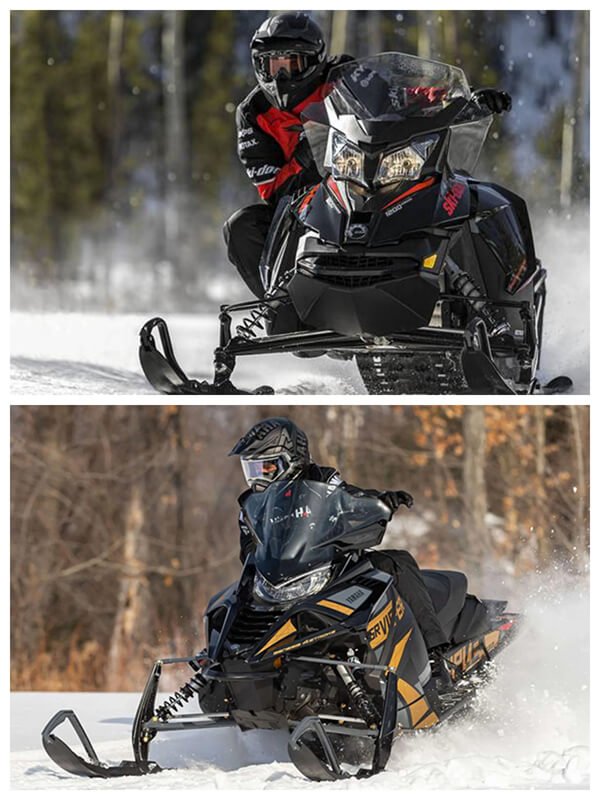
2016 Ski-Doo Renegade Sport and 2021 Yamaha SR Viper GT
Even though both are older models compared to today’s sleds, the contrast I felt between them perfectly illustrates the difference between 2-stroke and 4-stroke designs.
The Ski-Doo’s light frame and high-revving engine made it spring forward with every twist of the throttle. It felt playful, almost impatient — the kind of sled that begs to dart into corners and dance across fresh powder.
By comparison, the Yamaha was slower to respond at first, but when the torque kicked in, it pulled with a steady, relentless surge. The extra 200 pounds gave it a more grounded feel, especially on long, groomed trails, where it tracked straight and stable even at higher speeds.
In drag race testing, that split personality became unmistakable: the Ski-Doo leapt ahead off the line thanks to its lighter weight and quicker throttle response, but halfway down the run the Yamaha’s 4-stroke torque started reeling it in, overtaking smoothly and carrying its speed further.
In short, the numbers tell you what to expect, but the ride experience makes it real.
The 2-stroke is like a sprinter exploding off the blocks, while the 4-stroke is a marathoner hitting stride and never letting up.
Riders looking for quick bursts, playful handling, and aggressive off-trail fun will gravitate to 2-strokes, while those who prefer smooth, steady power for long-distance trail cruising and predictable control will favor 4-strokes.
Maintenance and Longevity: 2-Stroke vs 4-Stroke
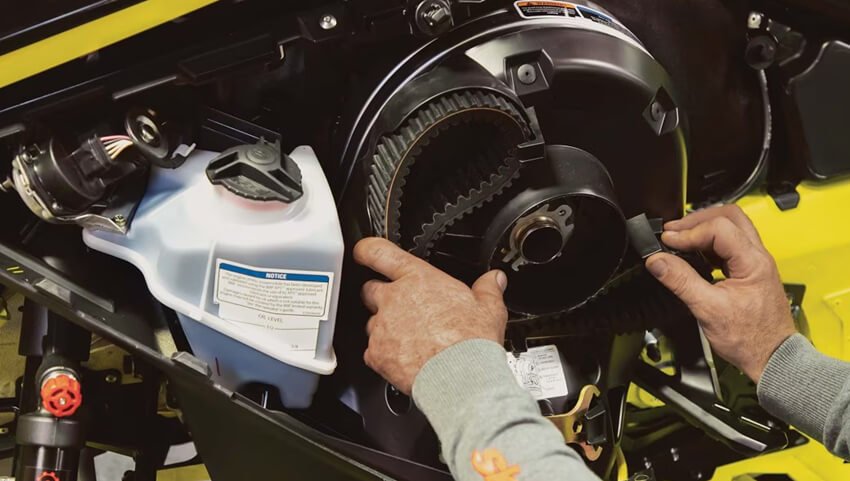
Snowmobile Maintenance
2-Stroke Engines
- Lifespan: Typically 5,000–8,000 miles before a top-end rebuild.
- Maintenance: Frequent oil/fuel mix checks, spark plug replacements, and piston inspections.
- Complexity: Simple design, easier for DIY repairs, but top-end rebuilds needed sooner.
4-Stroke Engines
- Lifespan: Often exceeds 15,000 miles; some models can reach 30,000–40,000 miles before major rebuilds.
- Maintenance: Regular oil changes and valve inspections; rebuilds are rare but more technical and costly.
- Complexity: More moving parts; daily upkeep is easier, but repairs require skill.
Summary:
2-strokes need more frequent minor attention and earlier major rebuilds but are mechanically simpler.
4-strokes last longer between major services, with less daily attention, but repairs are more complex.
Fuel Economy: 2-Stroke vs 4-Stroke
2-Stroke Engines
- Fuel Efficiency: Lower, typically 8–14 MPG depending on engine size and riding style.
- Oil Use: Requires oil mixed in fuel or via injection; extra attention needed during rides.
- Practical Impact: More frequent fuel stops and higher running costs.
4-Stroke Engines
- Fuel Efficiency: Higher, often 15–28 MPG; larger 900cc engines can still reach ~22 MPG.
- Oil Use: Separate crankcase oil, changed infrequently; no need to mix with fuel.
- Practical Impact: Fewer fuel stops, lower fuel costs, and more convenient for long-distance riding.
Summary:
4-strokes win on fuel economy, convenience, and lower running costs, while 2-strokes demand more fuel and oil management but offer lighter weight and quicker throttle response.
Noise and Emissions: 2-Stroke vs 4-Stroke
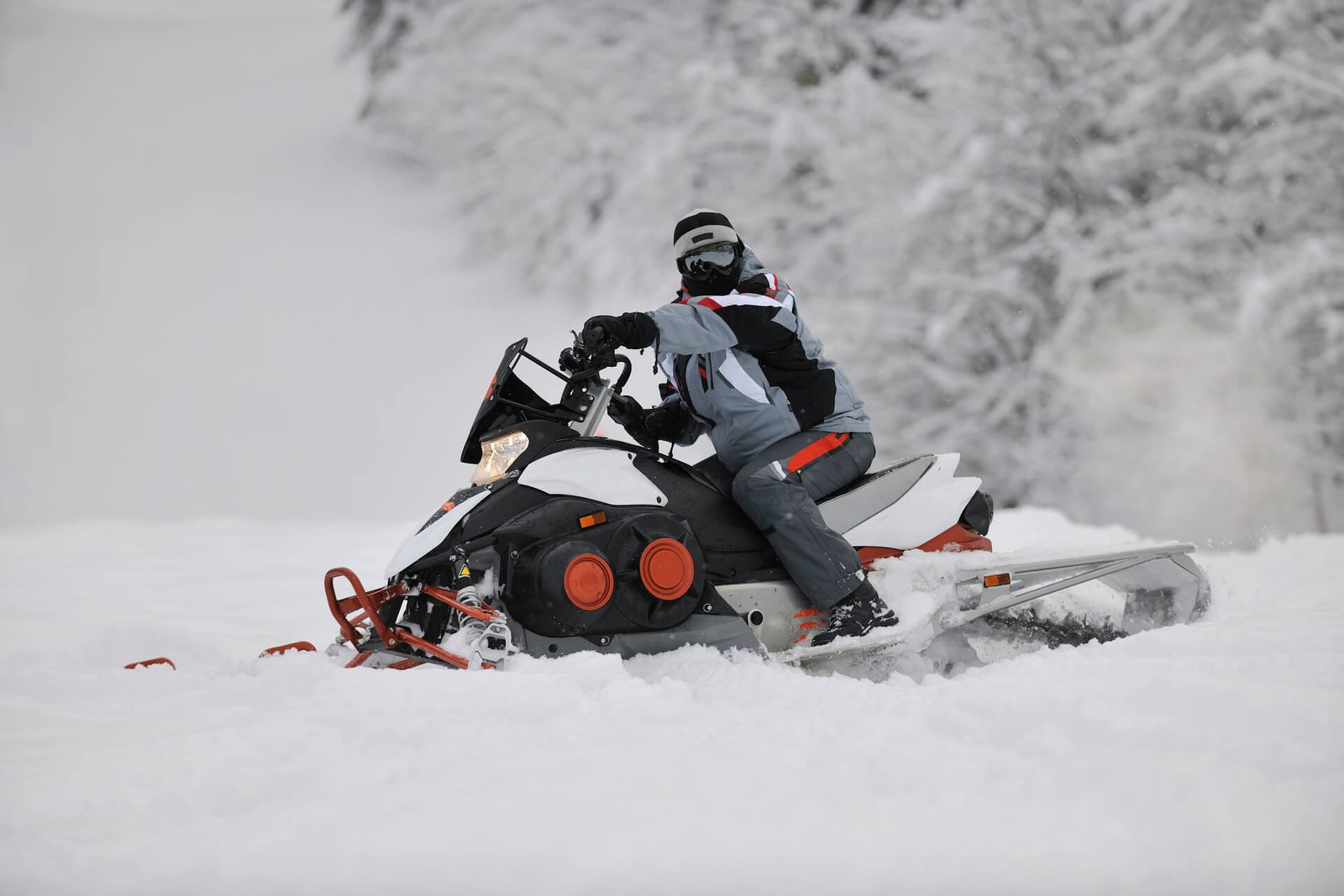
snowmobile noice
2-Stroke Engines
- Noise: Louder, more aggressive exhaust sound.
- Emissions: Smoky exhaust, burns oil; higher unburned hydrocarbons and carbon monoxide.
- Riding Impact: Thrilling but attention-grabbing; more noticeable smoke and smell.
4-Stroke Engines
- Noise: Quieter and smoother operation.
- Emissions: Cleaner-burning; fewer pollutants and almost no visible smoke.
- Riding Impact: More eco-friendly, less polluting, and comfortable for long rides.
Summary:
2-strokes offer excitement and character but are noisier and less clean, whereas 4-strokes provide a quieter, more environmentally friendly ride.
Riding Experience and Ease of Use for Beginners
For someone new to snowmobiling, the engine type can affect ease of use.
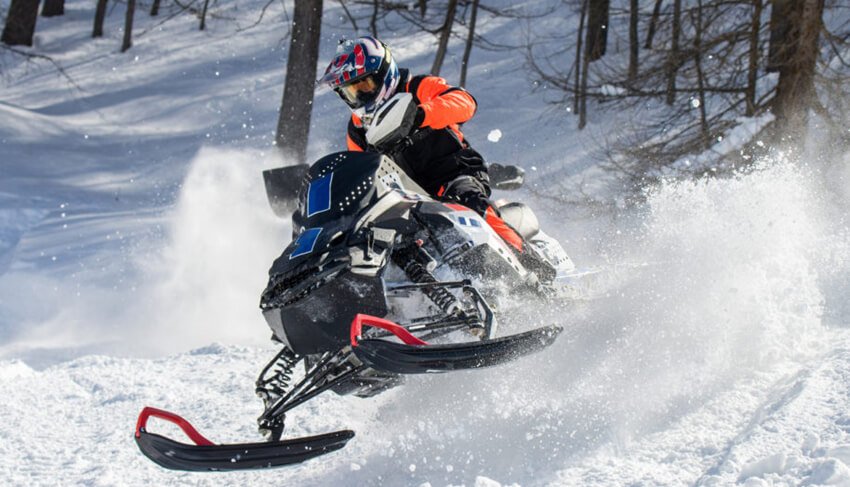
ride a snowmobile
4-stroke sleds tend to have a smoother, more predictable power delivery, which many beginners appreciate. They idle smoothly, you can cruise at low speed without hunting for the choke, and the throttle response is gentle. Trail riding on a 4-stroke is often described as comfortable and easygoing.
On the other hand, 2-stroke sleds deliver power very quickly. This “snappy” throttle can be thrilling but also requires some skill to manage, especially for a beginner.
If you like slow, steady riding on groomed trails, a 4-stroke is usually best. It won’t catch you off guard when you open the throttle, and it’s easier to start (especially in cold weather) because 2-strokes generally fire right up.
If you want to play off-trail, jump, or climb hills, a 2-stroke gives more performance for the pilot.
In short, a rider who enjoys blasting off-trail into deep snow and climbing hills will likely find a 2-stroke more exciting, while those who prefer cruising on groomed snowy trails may be better suited to a 4-stroke.
Cost Differences: Price, Maintenance, and Resale
When it comes to money, 2-strokes and 4-strokes differ in several ways:
- Purchase Price: 2-stroke snowmobiles generally cost less new. Entry-level 2-stroke trail sleds can often be found under $10,000, while comparable 4-strokes (especially high-end models) start around $12,000 and can exceed $15,000. More power and complexity in 4-strokes drive up the price.
- Maintenance Cost: 2-stroke engines are cheaper to rebuild (fewer parts, simpler design), but they need those rebuilds more often (every few thousand miles). 4-stroke parts (oil pumps, injectors) are costlier, but require service less frequently. Routine maintenance (oil change, filters) on a 4-stroke is similar to a car, whereas a 2-stroke demands frequent oil mixing and top-end checks. Over the lifetime of the sled, a diligent owner might spend several thousand dollars on top-end rebuilds for a 2-stroke, versus mostly oil and belt changes on a 4-stroke.
- Fuel/Oil Cost: Because 2-strokes burn more fuel and oil, their operating costs per mile are higher. One dealer pointed out that riding 1,000 miles on a 2-stroke might use 10 quarts of oil on top of gas. In contrast, a 4-stroke uses only engine oil changes.
- Resale Value: Opinions vary, but many experts note that 4-stroke sleds hold their value well because of their longevity. A 4-stroke engine can last 30,000–40,000 miles, which makes used 4-strokes attractive and resale prices strong. Some forums suggest 4-stroke values are generally better due to reliability (though interest in 2-strokes remains high among enthusiasts). In any case, expect a premium secondhand market for well-maintained 4-strokes, while used 2-strokes often sell on nostalgia and performance.
Overall, 2-strokes save money upfront but may cost more over time in fuel and rebuilds. 4-strokes are pricier to buy but can be cheaper to run if you ride a lot.
Safety Precautions: 2-Stroke vs 4-Stroke
Operating a snowmobile safely depends in part on understanding your engine type.
2-Stroke Engines:
- Avoid open/unbaffled exhaust systems.
- Warm up engine before riding.
- Check for leaks (crank seals) to prevent idling issues or engine failure.
- Be cautious with aftermarket exhausts; many clubs discourage them.
4-Stroke Engines:
- Warm up engine and perform routine maintenance (oil, valves, fuel system).
- Less noise restriction, but still inspect for leaks and mechanical issues.
- Summary: Both engine types require proper understanding and maintenance to ride safely and reliably.
2-Stroke vs 4-Stroke Snowmobiles Comparison Table
| Feature | 2-Stroke Snowmobiles | 4-Stroke Snowmobiles |
| Power & Acceleration | Pros: Quick throttle response, high power-to-weight ratio Cons: Peakier power delivery, fires every crank revolution |
Pros: Smooth, consistent power, strong low-end torque Cons: Slightly delayed throttle response, fires every other crank |
| Weight & Handling | Pros: Lighter frame (100+ lbs), easier to flick around corners Cons: Less planted at high speeds |
Pros: Heavier weight adds stability, tracks straight on groomed trails Cons: Harder to maneuver, slower steering response |
| Fuel Efficiency | Cons: Lower MPG (8–14), burns oil with fuel, frequent refueling | Pros: Higher MPG (15–28), separate crankcase oil, fewer fuel stops |
| Maintenance & Longevity | Pros: Simple design, easier DIY repairs Cons: Top-end rebuilds every 5k–8k miles, frequent oil/injection checks |
Pros: Long lifespan (15k–40k miles), mostly routine oil/valve maintenance Cons: More complex parts, repairs costlier |
| Noise & Emissions | Cons: Louder, smoky exhaust, burns oil, higher pollutants | Pros: Quieter, cleaner-burning, meets strict emissions standards |
| Cost & Resale | Pros: Lower purchase price, cheaper rebuilds Cons: Higher long-term fuel/oil costs, frequent rebuilds |
Pros: Higher resale value, less frequent maintenance Cons: Higher upfront cost, individual repairs more expensive |
| Intake & Aspiration | Generally naturally aspirated; simpler intake system | May be naturally aspirated or turbocharged; more complex intake system with valves and oil pump |
Which Engine Is Right for You?
For recreational riders, the choice often comes down to style and priorities:
- Trail Cruisers & Beginners: If your main riding is on groomed snow trails, a 4-stroke snowmobile is a safe bet. Its smooth power delivery, quiet operation, and better fuel economy make it ideal for long, steady rides. The extra weight isn’t a drawback on open trails, and the strong torque provides plenty of confidence.
- Mountain Riders & Performance Seekers: If you crave deep powder, steep climbs, and playful handling, a 2-stroke snowmobile is the better match. Its lighter frame and responsive throttle give it the agility to dart through trees, climb hills, and tackle technical terrain with ease.
- Cold Weather or Remote Riding: A 2-stroke is often easier to start in extreme cold, which helps in backcountry conditions. However, you’ll need to carry oil and perform more frequent checks. On the other hand, 4-strokes excel on long-distance trips thanks to their fuel efficiency and quiet ride.
- Budget & Long-Term Ownership: If you want a lower upfront cost and don’t mind occasional maintenance, a 2-stroke offers strong value. But if you plan to keep your sled for many years and log high mileage, a 4-stroke’s durability and lower long-term costs make it more practical.
❄️FAQ
1. 🔧 What is the difference between a 2-stroke and a 4-stroke snowmobile engine?
A 2-stroke engine completes its power cycle in two piston strokes, firing every crankshaft revolution, which gives it a lighter frame, higher power-to-weight ratio, and quicker acceleration.
A 4-stroke engine completes its cycle in four piston strokes, firing every other crankshaft revolution, which results in smoother power delivery, stronger low-end torque, and better fuel efficiency.
2. 🏁 Which engine is better for beginners?
4-stroke snowmobiles are usually recommended for beginners because they have smoother, more predictable power, quieter operation, and better fuel economy.
2-stroke sleds are more responsive and fun but require more skill to manage throttle and maintenance.
3. ⛽ How do fuel efficiency and oil use compare between 2-stroke and 4-stroke engines?
2-stroke engines have lower fuel efficiency (8–14 MPG) and require oil to be mixed with fuel.
4-stroke engines are more fuel-efficient (15–28 MPG) with a separate crankcase for oil, meaning fewer fuel stops and lower running costs.
4. 🛠️ How do maintenance and lifespan differ?
2-strokes typically need top-end rebuilds every 5,000–8,000 miles and more frequent oil/fuel checks. They are mechanically simpler but require more frequent maintenance.
4-strokes can last 15,000–40,000 miles before major service, with routine maintenance mostly limited to oil changes and valve checks. They are more complex but less demanding in daily upkeep.
5. 💰 Which engine type is more cost-effective?
2-strokes are cheaper upfront and have lower parts cost for rebuilds, but they consume more fuel and oil and require more frequent major maintenance. 4-strokes are pricier to buy, but their long-term running costs are lower, and they maintain higher resale value.
6. 🧊 Which one’s easier to start on a freezing morning?
2-strokes usually fire up quickly in cold weather—instant satisfaction. 4-strokes can be a bit temperamental, especially older models, but once they’re rolling, you barely think about them.
7. 👨🔧 Do 2-strokes require more attention?
Yes. They demand more TLC: oil checks, fuel mix, warming up. But that’s part of the fun for some riders—you feel more “in tune” with the machine. 4-strokes are more like a faithful companion: set it and ride, mostly worry-free.
8. Any advice for beginners who are undecided?
Think about your riding style: if you crave adventure and agility, go 2-stroke. If you want comfort, reliability, and long-distance ease, 4-stroke. And honestly, some riders have one of each—they pick based on mood and snow conditions.
Conclusion
Neither 2-stroke nor 4-stroke snowmobiles are universally “better.” Instead, the right choice depends on how and where you ride. Aggressive mountain and off-trail riders will get more excitement from a 2-stroke, while touring and trail-focused riders will appreciate the comfort and reliability of a 4-stroke.
Both engine types continue to improve, and all major brands still offer them — so your decision comes down to matching your riding style, budget, and priorities.

With over 10 years of experience working on cars and trucks Item Training Supervisor Richard Reina is known around the office as one of our technical experts & real an "automobile person".
His rate of interest began, in his very own words, "at the age of two when his father educated him the distinction in between a Chevy and a Ford. Since then it's been cars regularly."
As a serious lover of practically all things with a motor Richard can address nearly any kind of inquiry related to car upkeep, fixing, or restoration & is a fact professional in electric motor background.
Motorcycle riding is all about the sense of freedom, adventure, and thrill of the open road. But come on—being connected when you ride isn't always an easy thing. Whether you're riding with a buddy, navigating traffic in the city, or long-distance riding, effective communication is crucial. That's where the Fodsports T5 and T6 come in, […]
If you're looking for a new motorcycle intercom system this year, Fodsports has something exciting in store. The company has launched two new Bluetooth helmet intercoms: T1 and T1 Pro. Both models bring upgraded features, sleek design, and high-definition audio quality for riders who want to stay connected, entertained, and safe on the road. But […]
Fodsports T1 and T1 Pro: The Newest Bluetooth Intercoms for Riders. Whether you’re cruising on highways, exploring rugged trails, or commuting daily, clear communication is key. Fodsports is thrilled to launch its latest Bluetooth intercoms: the T1 and T1 Pro. Built for riders who demand reliability, versatility, and crystal-clear sound, these devices redefine how you […]
Many riders who aren't so tall or ladies just starting to ride bikes need to pick out the best Motorcycles for Short Riders and Women. They gotta look for three key things: a seat that's not too high up, a bike that's not too heavy, and something that looks good enough to give them confidence. […]
Fodsports FX 60C vs FX30C Pro: What's new techs are the FX 60C bringing to us? Fodsports is a brand worth-mention for helmet communication and video recording. This brand has established itself as a key player with its innovative Bluetooth camera intercom systems. Recently, Fodsports has released a new camera intercom, the FX 60C. How […]
